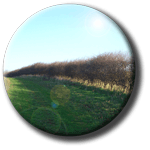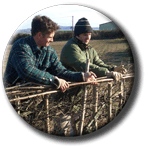Hedgerows
I
 n
England and Wales the Hedgerows Regulations 1997 are intended to protect important
countryside hedges from destruction or damage. The legislation is very complicated
and has been the subject of much criticism - not least from the poor souls who
have to try to administer it. The regulations are presently under government
review and are intended to be revised (this has been awaited since 1997 so we'll
believe it when we see it).
n
England and Wales the Hedgerows Regulations 1997 are intended to protect important
countryside hedges from destruction or damage. The legislation is very complicated
and has been the subject of much criticism - not least from the poor souls who
have to try to administer it. The regulations are presently under government
review and are intended to be revised (this has been awaited since 1997 so we'll
believe it when we see it).
Hedgerows in the countryside, and their conservation, is a quite
different subject from the management and regulation of hedges around houses,
and, more specifically, between neighbours. For this reason, the Hedgerows Regulations
1997 specifically exclude any hedgerow which is within, or borders, a domestic
garden. For these hedges other legislation exists. See here for a separate
article on high hedges and more information on 'problem' domestic hedges.
and more information on 'problem' domestic hedges.
See the text of the Hedgerows Regulations here
- although it might not make much sense unless you read this page too.
There is much confusion about 'when is it legal to trim
hedges?'. The Wildlife
and Countryside Act 1981 makes it an offence to disturb a birds nest which
is in use, which is normally taken to mean under construction, or with eggs,
chicks or birds using it regularly - even if they are not actually in it at
the time. There are no set timescales for this in law, and obviously this varies
from region to region. Here on the Isle of Wight I usually advise people not
to work from 1 March- 31 July, although plenty of people do so. The chances
of a prosecution are pretty slim but they have occurred. If work has to be done
to trees or bushes in the nesting season it is still possible to do it so long
as you inspect the trees beforehand and ensure there are no birds nests - obviously
if you find one you have to wait until it is no longer in use. Although this
might delay any work it certainly will not stop it as the work can proceed once
the nests have been finished with.
makes it an offence to disturb a birds nest which
is in use, which is normally taken to mean under construction, or with eggs,
chicks or birds using it regularly - even if they are not actually in it at
the time. There are no set timescales for this in law, and obviously this varies
from region to region. Here on the Isle of Wight I usually advise people not
to work from 1 March- 31 July, although plenty of people do so. The chances
of a prosecution are pretty slim but they have occurred. If work has to be done
to trees or bushes in the nesting season it is still possible to do it so long
as you inspect the trees beforehand and ensure there are no birds nests - obviously
if you find one you have to wait until it is no longer in use. Although this
might delay any work it certainly will not stop it as the work can proceed once
the nests have been finished with.
In the meantime this page should give some guide to the present
law. Take a deep breath because it is not a simple explanation - there isn't
one.
A hedgerow is 'a row of bushes forming a hedge, with the
trees growing in it'. Where a former hedgerow has grown up to form trees, it is
not covered by the regulations. The exact difference between a line of trees and
a hedgerow is not defined in law. This can be tricky, and it is, when it comes
down to it, a matter of opinion when a hedge becomes a line of trees. It is not
a simple case of height or width, or species or even management - probably all
these factors need to be considered. As a guide, if something was once a hedge,
in my view it remains a hedge until it very obviously is not one. However,
if trees remain from a larger woodland, for example, in a thin line, these might
not immediately be a hedge for some time even if they cover the same land area
as a hedge might. Other people might use different criteria to this. See, for
example, this article by
Alina Congreve in this section.
in this section.
Other field boundaries such as banks and stone walls are not
covered unless they support a hedgerow on top, as is often the case in the
West Country and parts of Wales. Even in this case it is only the hedgerow
itself that is protected, and not the feature underneath.
Hedgerows on or adjacent to the following:A
hedgerow is 'a row of bushes forming a hedge, with the trees growing in it'.
• Common
land
• Village greens.
• SSSIs (which include all terrestrial SACs
(which include all terrestrial SACs ,
NNRs
,
NNRs ,
and SPAs
,
and SPAs ).
).
• Local Nature Reserves
• Land used for agriculture.
• Land used for forestry.
• Land used for the breeding or keeping of horses, ponies or donkeys.
But not hedgerows (including any in the above list)
which are 'within or marking the boundary of the curtilage of a dwelling-house'.
This means that if a hedge marks the edge of a garden which is attached to a
house, the hedge is not covered by the regulations.
To qualify for the regulations a hedgerow must be at least
20m in length or connected at both ends to another hedgerow of any length. Any
stretch within such a hedgerow also counts. Gaps of up to 20m are counted as
a part of the hedgerow.
To uproot or otherwise destroy a hedgerow counts as removal.
So if you dig a trench alongside a hedge and kill off the roots, this is removal
even if you don't touch the hedge itself. But if you severely prune
or coppice back a hedgerow, even down to the roots; if the hedgerow is capable
of growing back it may not count as removal.
Of course. Aren't there always? Read on:
 Works
to hedgerows are exempt:
Works
to hedgerows are exempt:
• To make a new opening in substitution for an
existing one that gives access to land. For example, a gate. However, the
old one must be filled in within 8 months.
• To obtain temporary access to land in an emergency. This means the
sort of emergency you might dial 999 for- not the sort of emergency where
you've suddenly bought too big a combine for your field.
• To obtain access to land where other means are not available or are
only available at disproportionate cost.
• For national defence purposes.
• Where planning permission has been granted but not in most cases where
the development is under permitted development rights.
• To carry out work under certain Acts of Parliament for flood defence
or land drainage purposes.
• By an authorised inspector to prevent the spread of a plant disease.
• By the Highway Agency.
• To protect or prevent danger to electric lines and plant.
• For the proper management of the hedgerow. This means real management,
such as coppicing. But if the hedgerow is deliberately 'overmanaged' this
might qualify as removal.
Any landowner who wishes to remove a hedgerow, if it is
not exempt as above must serve a Hedgerow Removal Notice in writing on their
local planning authority. The authority then has 42 days (which period can be
extended if the applicant agrees) to determine whether or not the hedge is considered
'important' under the regulations, and if so, whether or not to issue a Hedgerow
Retention Notice. The local authority does not have to issue a Retention Notice,
even if the hedgerow counts as important. If they do not issue a notice for
an important hedge this is often on condition that certain things are done,
e.g. reinstatement or replanting to a certain standard, or creation of an equivalent
boundary elsewhere.
Considering the Hedgerow Removal Notice.
The local authority must consult the local parish or community council and consider
their views, but it does not have to consult anyone else. All applications are
kept on a public register and should be available for study at your local authority.
There is no requirement to publicise the order or put up signs, or anything
like that. The local authority may (but does not have to, for example if the
information is already available) then make a site survey. This must be done
by a suitably qualified individual. From this the authority will determine whether
or not the hedge is 'important'. In this context the word 'important' has special
meaning.
A good question. The definition in the official literature
runs to 6 closely-printed A4 pages. So this is a brief overview; if it's important
to you then check the detail because it's not all here. Oddly, most of these
criteria refer to 'the relevant date' which is 27 March 1997. If records giving
evidence to support inclusion in these criteria cannot be shown to have existed
on that date, they may not qualify. In any case the hedgerow must be more than
30 years old. The landowner should provide documentation to prove that it is
not, if he thinks so. Apart from this, to be deemed 'important' a hedgerow must
meet one or more of the following criteria:
• The hedgerow marks the boundary of a historic
parish or township existing before 1850.
• The hedgerow contains or is within an archaeological feature which is
on the Sites and Monuments Record, or a pre-1600 manor or estate.
• The hedgerow is a part of or associated with a field system predating
the Inclosure Acts.
• The hedgerow contains species in part I of Schedule
1 ;
Schedule 5
;
Schedule 5 ;
or Schedule 8
;
or Schedule 8 of the Wildlife and Countryside
Act 1981
of the Wildlife and Countryside
Act 1981 ;
or various other defined species including certain Red Data Book species.
;
or various other defined species including certain Red Data Book species.
• The hedgerow is adjacent to a public
right of way (not counting an adopted highway) and at least 4 woody species as defined in
Schedule 3 of the regulations plus at least two Associated Features.
(not counting an adopted highway) and at least 4 woody species as defined in
Schedule 3 of the regulations plus at least two Associated Features.
• The hedgerow includes one or more of the following:
- At least 7 woody species;
- At least 6 woody species plus at least three Associated Features (see below);
- At least 6 woody species including a black poplar; large-leaved lime, small-leaved
lime or wild service tree;
- At least 5 woody species and at least 4 Associated Features.
| Note that: Where a hedgerow
is situated wholly or partly in the county (as constituted on the first
of April 1997) of the City of Kingston Upon Hull, Cumbria, Darlington, Durham,
East Riding of Yorkshire, Hartlepool, Lancashire, Middlesbrough, North East
Lincolnshire, Northumberland, North Yorkshire, Redcar and Cleveland, Stockton-on-Tees,
Tyne and Wear, West Yorkshire or York the number of woody species mention
is to be treated as reduced by one" |
Associated Features are as follows:
• A bank or wall for at least half the length.
• A ditch for at least half the length.
• Gaps over no more than 10% of the length.
• At least one standard tree per 50m.
• At least 3 ground flora woodland species as defined in Schedule 2
of the Regulations within 1m of the hedgerow.
• Connections scoring 4 or more points, where connection a hedgerow
counts as one, a broad-leaved woodland or pond counts as two*.
• A parallel hedge within 15m*.
*These features do not count if a public right of way is being
included in the criterion.
 Use
these links to find out more about Hedgelaying and Hedge Management.
Use
these links to find out more about Hedgelaying and Hedge Management.
National Hedgelaying Association
See especially this
excellent essay on the origin, management and regional variations of hedges
by Paul Blissett.
If you are seriously interested in hedgerow planting and management for conservation
you need the BTCV Hedgerows Practical handbook, which, frustratingly, is no longer a printed publication but in a move worthy of Adobe, you can pay for a chance to view it online. If you can find an old printed copy keep it under lock and key, they are rare.
For a critical overview of the Regulations in the year 2000 see the article
Hedgerow Protection
in England and Wales by Alina Congreve.
by Alina Congreve.
A further article by the same author is How
to survey a hedge according to the 1997 Regulations .
.
Did that help? We thought not.
It is a nightmare to administer and use, and we really hope it changes soon.
In the meantime, you are recommended to obtain The
Hedgerows Regulations 1997, a guide to the law and good practice,
published by the Department of the Environment in 1997. Even that doesn't have
everything in it, but it is a good start. You can download it in bits from this Government page.
There's also the Government pages on hedgerows here.

 n
England and Wales the Hedgerows Regulations 1997 are intended to protect important
countryside hedges from destruction or damage. The legislation is very complicated
and has been the subject of much criticism - not least from the poor souls who
have to try to administer it. The regulations are presently under government
review and are intended to be revised (this has been awaited since 1997 so we'll
believe it when we see it).
n
England and Wales the Hedgerows Regulations 1997 are intended to protect important
countryside hedges from destruction or damage. The legislation is very complicated
and has been the subject of much criticism - not least from the poor souls who
have to try to administer it. The regulations are presently under government
review and are intended to be revised (this has been awaited since 1997 so we'll
believe it when we see it). Works
to hedgerows are exempt:
Works
to hedgerows are exempt: